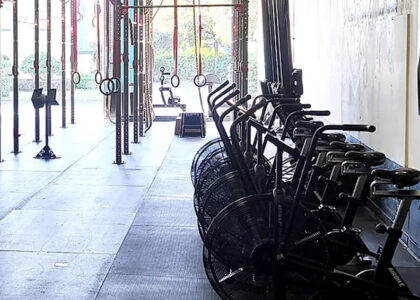Since its founding in 2000, CrossFit has shown that glitz and gadgets aren’t necessary to reap some serious health and fitness benefits. (Although sometimes, a bit of fitness tech or a trendy fit accessory can be a motivating splurge.) Step into a CrossFit box and you’ll see the textbook definition of “no frills” — and the same can be said about the workout programs, which are made up of a variety of low-tech, functional movements that combine gymnastics, weight training, Olympic weight training, and metabolic conditioning with an emphasis on intensity.
And while, yes, CrossFit prides itself on being bare-bones, the benefits of the exercise are anything but minimal. Read on to learn 14 science- and expert-backed benefits of CrossFit that just may convince you to sign up for a box.
Makes You Stronger
Spoiler alert: Lifting weights, Olympic weightlifting, and resistance training all make you stronger, and CrossFit uses all of these fitness modalities in its programming. Even better, the movements you do during your workouts target more than just one muscle group. Gotta love efficiency!
“Most of the movements you do in CrossFit are compound movements, meaning they recruit muscles from all over your body,” says Grayson Wickham, D.P.T., C.S.C.S., a physical therapist and founder of Movement Vault. For instance, when you’re doing a lift such as a snatch, squat, or deadlift, you’re activating and therefore strengthening all of your muscles from head to toe.
In fact, one 2017 study found that compound movements (also called multi-joint exercises) are more effective for improving strength and general fitness compared to single-joint exercises such as the biceps curl, calf raise, or leg curl.
Burns Calories Efficiently
Speaking of efficiecy, when researchers from the University of Wisconsin–La Crosse looked at women who do CrossFit, they found that they burned 12 or more calories per minute. Their conclusion: “CrossFit works.” “Based on the high intensity of the workouts tested, [we] conclude that CrossFit does a really good job of helping exercisers improve their aerobic fitness while burning a fair number of calories in the process,” reads the study.
The reason why comes back to the fact that the routines are heavy with compound exercises, says Tony Carvajal, a certified CrossFit trainer with RSP Nutrition. “The more muscles being used, the more calories you’re going to burn,” he says. FYI, you don’t necessarily have to pick up weights to score the benefits of compound moves; bodyweight staples such as burpees, muscle-ups, and handstands will light up your whole body.
Keeps You Burning Calories Post-WOD
Most CrossFit workouts (aka workouts of the day or WODs) will include some weightlifting — and lifting weights doesn’t just burn calories mid-workout, but after it too. That’s because your muscle mass is one of the main determining factors of your metabolic rate, meaning how many calories you burn just by living, explains Wickham. “In CrossFit, you’re going to gain muscle. More muscle mass means a faster metabolism. Faster metabolism means burning more calories all day long,” he says.
There’s also the “afterburn effect” (also known as excess post-exercise oxygen consumption or EPOC) which says that the more intense the exercise is, the more oxygen your body consumes afterward, and therefore the more calories you burn even after you’ve left the gym. That post-workout calorie burn is usually 6 to 15 percent of the total calories you burned while exercising. Not too shabby, CrossFit.
Might Help with Weight Loss
Losing weight isn’t everyone’s goal going into CrossFit, but if it’s yours, it’s “one of the most effective workouts for weight loss,” says Carvajal. That’s because all of the health and fitness benefits of CrossFit listed thus far — especially the increased lean muscle mass and the boosted metabolism — contribute to reducing body fat and burning more calories overall.
There’s a psychological component of the program that makes it effective as a weight-loss program too, says physical therapist D.R. Ebner, P.T., C.S.C.S., at the Ohio State University Wexner Medical Center. “The community will keep you coming back. It’ll keep you on track and make you 10 times more likely to show up,” he says.
Heart-Healthy
Most CrossFit WODs don’t look like traditional cardio training methods — rather, some are only three minutes long. However, it’s totally possible to get a cardiovascularly challenging workout in a short amount of time — even just three to five minutes, Tanya Wagner, a CrossFit Level 2–certified trainer at CrossFit Apex in Bucks County, Pennsylvania. In fact, a study published in PLoS ONE found that just three minutes of all-out exercise per week significantly improved cardiometabolic health markers (including VO2 max and blood pressure) in overweight/obese adults.
Improves Your Mobility
It may not look like traditional mobility-building practices such as yoga and Pilates but, “CrossFit is actually one of the best exercise programs for enhancing mobility,” according to Wickham. Quick refresher: Mobility is your ability to move a muscle or muscle group through a range of motion (ROM) in the joint socket with strength and control. Many movements in these workouts simultaneously enhance ROM and strength. For example, try improving your mobility the CrossFit-approved way with this squat therapy drill.
Safer Than It Looks
CrossFit gets a bad rap for being unsafe, but a 2018 review concluded that, while the sport has been scrutinized because of the supposed high incidence of injuries, none of these claims were supported by empirical evidence.
Another study found that people who work with hands-on coaches who help them through the movements have fewer injuries — and that’s exactly what most CrossFit boxes offer. As for rhabdo, it’s not any more common in CrossFit than in any other type of high-intensity exercise.
Could Even Reduce Injury Risk
The best exercises to perform inside the gym are ones that mimic the movements you do outside the gym, says Wickham. (Think: Hauling a heavy package in from your doorstep, sitting down and getting up from your desk, or schlepping a heavy duffle bag.) These are called functional movements — and they’re the foundation of many CrossFit WODs.
“The whole point of doing functional movements as exercise is to keep your body in physical readiness for the demands of everyday life,” explains Wagner. If people learn to properly move their bodies as an entire unit or machine, they’ll be much more successful and safe during more demanding everyday tasks such as shoveling snow or moving furniture, she says.
Makes You Run Better
CrossFit improves your strength from head to toe, and that means improved performance — whether you’re an endurance athlete or sprinter. Research shows that running efficiency is improved when runners add two or three days of strength training to their workout routine every week.
Not to mention “CrossFit helps you strengthen your core,” says Ebner. “A strong core helps transfer strength and utilize the strength throughout the rest of your body, including your arms and legs,” he explains. Translation: more power per stride. Plus, a stronger core could improve your running form — which means a reduced risk of injury.
Helps You Rest Easier
“There are a lot of lifestyle factors that come into play with how well you sleep,” says Kevin Turcio, a NASM-certified personal trainer and owner of Affinity Athletics in Stamford, Connecticut. “In personal experience, CrossFit has helped me fall asleep,” he adds. This could be simply due to the intensity involved in this kind of training, as upping the intensity of exercise has been shown to aid deep sleep.
This effect may be especially noticeable in folks who weren’t regular exercisers previously, suggests Carvajal. “Any type of exercise is likely to improve sleep quality; however, high-intensity training like CrossFit seems to be the most effective,” he says.
Gives You a Confidence Boost
CrossFit doesn’t only train your muscles — it trains your brain too. “CrossFit creates mental toughness,” says Wagner. That’s because the workouts give you the opportunity to use positive self-talk and push yourself through challenging moments.
“It allows you to self-evaluate and reflect once you’ve made it through whatever barrier you accomplished,” says Wagner. “We see incredible changes in self-talk and mental positivity levels specifically in women and adolescent girls,” she adds.
Super Time-Efficient
Most classes are only one hour long and the WODs themselves are usually only three to 20 minutes long. Seriously! (The rest of the class includes a warm-up, a cool-down, and sometimes an additional weightlifting portion.) “People are always surprised how wiped they are after such a short workout,” says Turcio. And there’s research to prove that longer isn’t always better. One study found that short bouts of HIIT are superior to moderate-intensity “slow and go” training for improving cardiovascular fitness.
Includes a Built-In Support System
Friendly PSA: If you’re in the ~no new friends~ club, CrossFit isn’t for you. That’s because throwing around weights and learning new gymnastics skills together have the amazing ability to create lasting friendships and a sound support system. There’s even science to prove it! A research review concluded that CrossFit is associated with a sense of community, satisfaction, and motivation. (And it’s not exactly breaking news that having a partner in crime helps people reach their fitness goals: Why having a fitness buddy is literally the best thing ever.)
“The community will support you and encourage you and keep you accountable to your goals,” says Carvajal. “Being in an environment like this can only lead to bettering yourself in and out of the gym,” he notes.
Guaranteed Fun
Yes. F-U-N. Research shows that, for many people, hard workouts are actually more fun. So, sure, CrossFit may be hard, but you’ll be reaping a whole lot of benefits and having a good time doing it.



